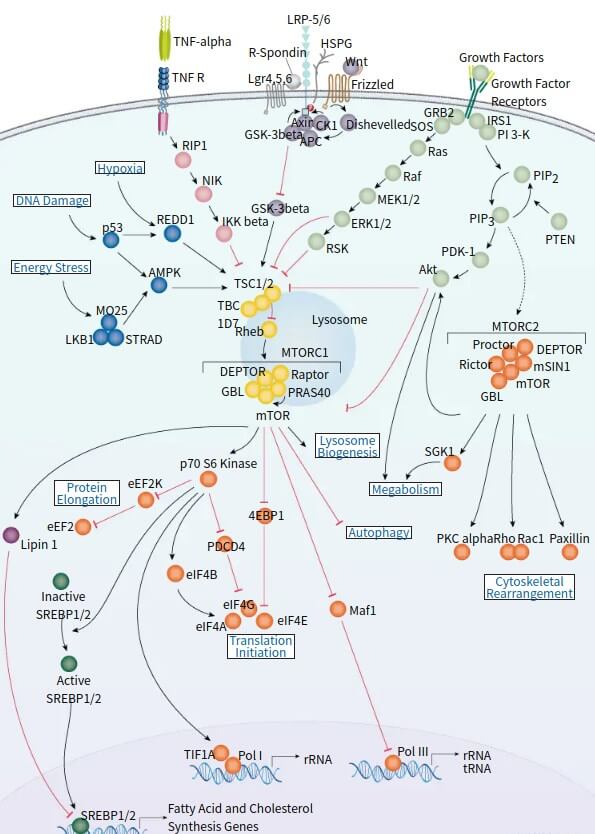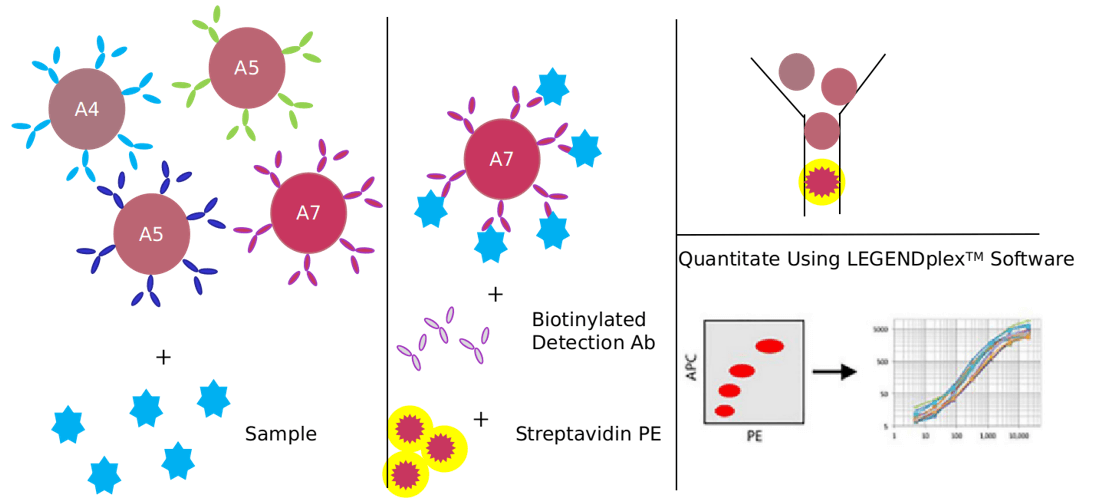mTOR signaling pathway
Based on Luminex technology platform, Creative Proteomics provides analysis services for key targets of mTOR signaling pathway.
The mammalian target of rapamycin (mTOR) is a key protein evolutionarily conserved from yeast to man and is essential for life. The mTORC1 complex is made up of mTOR, Raptor, mLST8, and PRAS40, and the mTORC2 complex is composed of mTOR, Rictor, Sin1, and mLST8.
mTOR signaling pathway serves as a master regulator of cell metabolism, growth, proliferation and survival. mTORC1 positively regulates cellular metabolism and ATP production, as well as controlling the synthesis of lipids for membrane generation in proliferating cells and promoting cellular growth by negatively regulating autophagy. The mTORC2 complex promotes cellular survival, regulates cytoskeletal dynamics, and controls ion transport and growth. Aberrant mTOR signaling is involved in many pathological conditions including cancer, cardiovascular disease, diabetes, obesity, and neurodegeneration. Thus, mTOR inhibitor use in treating solid tumors, rheumatoid arthritis, coronary restenosis, organ transplantation, and other diseases is growing and increasing our knowledge of the role of the mTOR pathway in health, disease, and aging.
mTOR appears to play a central role in signaling caused by nutrients and mitogens such as growth factors to regulate translation. The drug rapamycin acts on mammalian cells through the mTOR protein kinase, also known as FRAP. When bound to the immunophilin binding protein FKBP12, rapamycin inhibits mTOR kinase activity and has immunosuppressant activity. Rapamycin and the mTOR inhibitor CCI-779 are being tested as anti-cancer agents, acting to block mitogenic signaling. The phosphorylation of p70S6K and 4EBP by mTOR and the phosphorylation downstream of RPS6 and EIF-4B stimulate translational initiation and contribute to cell growth (see also the Regulation of eIF4e and p70 S6 Kinase pathway).

Our detectable targets:
| TNF R | LRP-5 | LRP-6 | HSPG | Wnt | IRSI |
| PIP2 | PIP3 | PTEN | Ras | Raf | MEK1 |
| MEK2 | ERK1 | ERK12 | RSK | APC | GSK-3beta |
| RIP1 | NIK | IKK beta | REDD1 | p53 | MO25 |
| AMPK | LKBI | eEF2 | eEF2K | eIF4A | eIF4B |
| eIF4E | eIF4G | PDCD4 | 4EBP1 | Maf1 | SGK1 |
| AKt | TSC1 | TSC2 | PDK-1 | Rac1 | Paxillin |
| S6 | Lipin1 | SREBP1 | SREBP2 | TIFIA | Pol I |
| Pol III |
Technology platform
We provide Luminex technology for mTOR signaling pathway analysis.
Luminex technology is a multifunctional liquid phase analysis platform developed on the basis of colored microspheres, laser technology, applied fluidics and high-speed digital signal processing technology. The core is to encode polypropylene microspheres or magnetic microspheres with fluorescent dyes. By adjusting the different ratios of the two fluorescent dyes, up to 100 microspheres with different fluorescence spectra can be obtained. Each kind of microspheres is covalently cross-linked. Capture antibodies against specific antigens.
The mammalian target of rapamycin (mTOR) signaling pathway is the main regulator of cell metabolism, growth, proliferation and survival. It plays a key role in protein synthesis, control of proliferating cells, and promotion of cell growth.
In addition to Luminex Multiplex Assay, Enzyme-linked immunosorbent assay (ELISA), Flow cytometry (FACS analysis) technology can also be provided to meet other customer needs.
Advantages of mTOR signaling pathway detection:
- Versatility: VEGF signaling pathway technology can be applied to a variety of biological tests, including immune analysis, genotyping, gene expression, enzyme analysis, etc. It can detect both protein and nucleic acid. In addition to clinical use, it can also be used in scientific research, CDC, blood stations, agricultural, biological and pharmaceutical professional laboratories.
- High-throughput and high-speed: Each microsphere is used as a separate test body, which can perform a large number of biological tests at the same time. It only needs 10~201 samples to test up to 100 indicators at a time, and the fastest can reach 10,000 tests /hour.

Application of our service:
- To study the effect of each virus on mTOR signaling pathway
- To study the effects of drugs or therapies on mTOR signaling pathways
- To study the regulation mechanism of mTOR signal pathway in disease
Creative Proteomics has developed a signal pathway target detection platform. We are not limited to providing mTOR signaling path detection services, but can also provide other signal path detection services. If you want to detect other targets, please contact us and we will customize the service for you. Look forward to working with you.
References:
- M.Berry, Z. Ahmed, et al. "Prospects for mTOR-mediated functional repair after central nervous system trauma," Neurobiology of Disease, 2019, 85: 99–110.
- H. Kanno, H. Ozawa, et al. "The role of mTOR signaling pathway in spinal cord injury," Cell Cycle, 2018, 11(17): 3175–3179.



